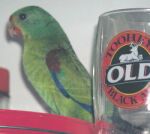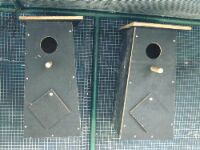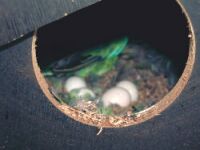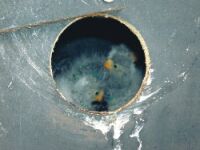
|
The 2001 Breeding Season with the Swift Parrot. |

|
The 2001 Breeding Season with the Swift Parrot. |
|
It seemed that everything weather wise that could go wrong this year did go wrong!! Last spring and summer the state (Tasmania) was gripped in the driest spell on record and this season we have broken all records for the wettest spring - never a dull moment. We appear to have the opposite of NSW weather. Last year NSW was under water and this year you had bush fires and no rainfall during this same period. The only major differences between the two areas are the heat and the humidity - we don't have any!! Perhaps the only good thing about this is that it makes breeding the swift parrot a lot easier. High humidity and consistent temperatures over 25 degrees Celsius and you can forget about naturally rearing swift parrots - this coming from several breeders that I have spoken with. No such worries with that as it is official, the first 10 days of summer 2001 have been the coldest on record!! At the start of the 2001 season our first round of eggs and chicks were lost to torrential rain and high winds which lifted the protective covering over the nest boxes and deposited them all over the yard! The unsettled nature of the weather appeared to be reflected in the behaviour of the birds. Normally reliable hens were flighty and previously excellent parents neglected chicks. However, through this weird carrying on I was able to gain my first experience at hand raising a swift parrot. When Rob McGuiness (remember, I'm not allowed to actually move my birds back to my own aviaries!!) rang and told me that we had lost all but 1 chick from a nest of 5 (previously 3-4 eggs were our normal clutch) we went in to over drive to ensure this sole survivors salvation. When it arrived it was cold, wet and very miserable but it soon showed itself to be a true battler and is now madly zipping around the house as I write and has made several 'additions' to the computer keyboard - everyone's a critic! Our Wildlife authorities, in their generosity, allowed me to keep the swift until he was old enough to be reintroduced into the colony. This swift parrot has to be the best parrot that I have ever hand reared and all that come onto contact with him want to take him home. Wonder if our Wildlife department would go for that idea!! As you can see from the photos he is very partial to a Tooheys Old or a chilled white wine! |


|
| The baby swift was reared on Roudybush and was kept in a brooder setup
as shown to me a while back by Gordon Dosser - one of the greatest 'parrot
people' that I have been privileged enough to meet.
After these initial set backs all of our breeding pairs recommenced operations and this time the weather was moderate enough for them to proceed without any major upheavals. However, just in case, the hand rearing boxes were cleaned up and readied for action. At the time of writing there are several young flying and a number of chicks and eggs still to make their way out into the great outdoors. It is interesting to note that many of the hens had 2-3 rounds of eggs where, previously, they only laid once. The weather orů who knows? |

Rather than go into great detail about the diet and housing again I will refer you to the August/September 2001 edition of the Avi-Trader as a record of this information - the aviary pictured was where most breeding took place. The pictures accompanying this article speak for them selves as to the health and success of our breeding so far this season. However, we were a little perplexed this season with the amount of condensation that was forming inside the nest boxes. Previously we used a combination of nest boxes and natural hollow logs but this year Rob 'acquired' some marine ply, so new nest boxes were constructed. Just to show you that two sets of combined years of bird breeding count for nothing on occasions, we had neglected to drill 'breather' holes in the top of the sides of the boxes! This created a sweatshop inside the boxes. Neither of us was game enough to take the Black and Decker to the nest boxes with the chicks inside so Rob simply propped the lids of the boxes up with small chocks of wood. Airflow restored no more wet boxes. |


As a little aside at this point I must admit that I have never seen swift parrots as tame as the ones in Robs care. He inspects the nest boxes about 2-3 times every day and the sitting hens do not even bother to leave the box. When he first took me into the breeding flight for an 'inspection' I shuddered when it became apparent that he was literally going to SHOW me the chicks!! He would open the inspection holes and poke and prod the chicks/mother out of the way to fully examine the contents of the box - by this time I near fainted! He then proceed to tell me that the nest was so clean because he had tipped the chicks into a ice cream bucket yesterday so that he could fully clean it out. Yea gods, my frail heart! Under his care these birds were more like show budgies! He has actually watched the mother feeding the chicks while he was peering through the inspection hole on a number of occasions - when I had mine years ago I was too scared to even touch the logs when they were breeding. Once he was telling me about the history of the chicks in a particular nest box he was inspecting when the hen swift stuck her head out of the inspection hole and bit him - then retreated to the depths of the box for a good chuckle no doubt! With the degree of dedication that Rob has shown he is always aware when things are not going right and can intervene before a clutch is lost. A true aviculturist. |
| As to the legislation, well that is another matter! We read recently about 16 birds being sent to Adelaide Zoo as the start of a breeding program to 'save the species from extinction', or words to that effect. Most Tasmanian aviculturists wish the bird department at Adelaide Zoo all the best for this endeavour but question the logic of sending a species from an area that they naturally choose to migrate to into a climate where the summers can be a tad 'warm'. Would anyone question a breeding program for the Golden Shouldered Parrot based in Hobart?! It really doesn't say much for their confidence in Tasmanian aviculturists that they exclude them from any attempt to manage a captive breeding population - save to supply birds to another state! Does make you wonder about the logic circuits in the 'law makers' that declare that a species is endangered yet do all in their power to exclude any captive based recovery in its natural breeding zone. But what do I know!! |

My thanks to Rob McGuiness for making this article possible and for his work in making his charges so tame that a clot like me could photograph them! And also to Anthony McGuiness for the use of some of his photos. By Marcus Pollard - Copyright remains with the author. |